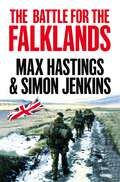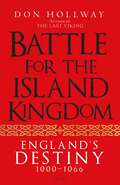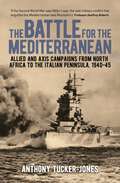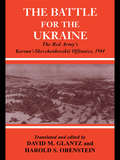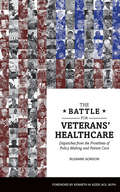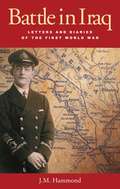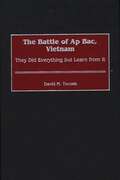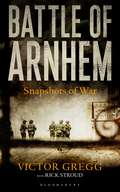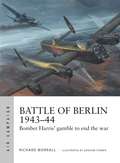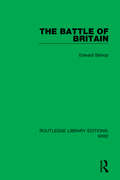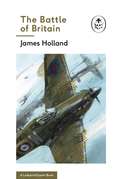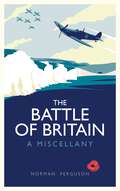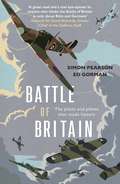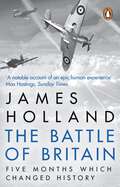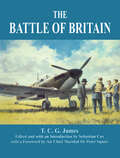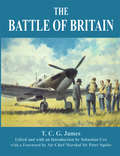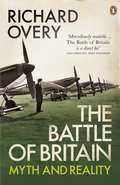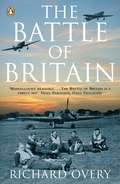- Table View
- List View
The Battle for the Falklands
by Max Hastings Simon JenkinsThe Falklands War was one of the strangest in British history – 28,000 men sent to fight for a tiny relic of empire 8,000 miles from home. At the time, many Britons saw it as a tragic absurdity, but the British victory confirmed the quality of British arms and boosted the political fortunes of the Conservative government. But it left a chequered aftermath; it was of no wider significance for British interests and taught no lessons. It has since been overshadowed by the two Gulf Wars, however, its political ramifications cannot be overestimated. Max Hastings’ and Simon Jenkins’ account of the conflict is a modern classic of war reportage and the definitive book on the war. Republished as part of the Pan Military Classics series, The Battle for the Falklands is a vivid chronicle of a call to arms and a thoughtful and informed analysis of an astonishing chapter in the history of our times.
Battle for the Island Kingdom: England's Destiny 1000–1066
by Don HollwayA rich history of the years leading up to 1066 when Vikings, Anglo-Saxons and Normans vied for the English crown. A tale of loyalty, treason and military might. In a saga reminiscent of Game of Thrones and The Last Kingdom, Battle for the Island Kingdom reveals the life-and-death struggle for power which changed the course of history. The six decades leading up to 1066 were defined by bloody wars and intrigues, in which three peoples vied for supremacy over the island kingdom. In this epic retelling, Don Hollway (The Last Viking) recounts the clashes of Vikings, Anglo-Saxons and Normans, their warlords and their conniving queens. It begins with the Viking Cnut the Great, forging three nations into his North Sea Empire while his Saxon wife Aelfgifu rules in his stead and schemes for England's throne. Her archenemy is Emma of Normandy, widow of Saxon king Aethelred, claiming Cnut's realm in exchange for her hand in marriage. Their sons become rivals, pawns in their mothers' wars until they can secure their own destinies. And always in the shadows is Godwin of Wessex, playing all sides to become the power behind the throne until his son Harold emerges as king of all of England. But Harold's brother Tostig turns traitor, abandons the Anglo-Saxons and joins the army of the last great Viking, Harald Hardrada, where together they meet their fate at the battle of Stamford Bridge. And all this time watching from across the water is William, the Bastard, fighting to secure his own Norman dukedom, but with an eye on the English crown.
Battle for the Island Kingdom: England's Destiny 1000–1066
by Don HollwayA rich history of the years leading up to 1066 when Vikings, Anglo-Saxons and Normans vied for the English crown. A tale of loyalty, treason and military might. In a saga reminiscent of Game of Thrones and The Last Kingdom, Battle for the Island Kingdom reveals the life-and-death struggle for power which changed the course of history. The six decades leading up to 1066 were defined by bloody wars and intrigues, in which three peoples vied for supremacy over the island kingdom. In this epic retelling, Don Hollway (The Last Viking) recounts the clashes of Vikings, Anglo-Saxons and Normans, their warlords and their conniving queens. It begins with the Viking Cnut the Great, forging three nations into his North Sea Empire while his Saxon wife Aelfgifu rules in his stead and schemes for England's throne. Her archenemy is Emma of Normandy, widow of Saxon king Aethelred, claiming Cnut's realm in exchange for her hand in marriage. Their sons become rivals, pawns in their mothers' wars until they can secure their own destinies. And always in the shadows is Godwin of Wessex, playing all sides to become the power behind the throne until his son Harold emerges as king of all of England. But Harold's brother Tostig turns traitor, abandons the Anglo-Saxons and joins the army of the last great Viking, Harald Hardrada, where together they meet their fate at the battle of Stamford Bridge. And all this time watching from across the water is William, the Bastard, fighting to secure his own Norman dukedom, but with an eye on the English crown.
The Battle for the Mediterranean: Allied and Axis Campaigns from North Africa to the Italian Peninsula, 1940-45
by Anthony Tucker-Jones"This book provides a strategic overview of the war that is interweaved with fascinating personal accounts, its campaigns and battles." - Professor Geoffrey Roberts.If the Second World War was Hitler's war, the vast military conflict that engulfed the Mediterranean between 1940 and 1945 was Mussolini's. In this exciting and illuminating account, Anthony Tucker-Jones explores the major campaigns across the whole Mediterranean, from the struggle for control of the Suez Canal to the Allied landings in the French Riviera in the summer of 1944. Includes: • Battle for Crete •The Desert Air War• Second Battle of El Alamein• Operation Crusader • Invasion of Sicily (Operation Husky)The actions of famous generals are introduced, including Erwin Rommel, Bernard Montgomery and George S. Patton, and how their strategic offensives pushed back Axis forces. Augmented by fascinating photographs and forwarded by Professor Geoffrey Roberts, The Battle for the Mediterranean tells the story of an all-encompassing conflict, by land, air and sea.
Battle for the Ukraine: The Korsun'-Shevchenkovskii Operation (Soviet (Russian) Study of War)
by David M. Glantz Harold S. OrensteinA comprehensive guide to the battle for the Ukraine from the Soviet perspective during the winter of 1943-1944. This volume is an unexpurgated translation of the originally classified Soviet General Staff Study No.14.
Battle for the Ukraine: The Korsun'-Shevchenkovskii Operation (Soviet (Russian) Study of War)
by David M. Glantz Harold S. OrensteinA comprehensive guide to the battle for the Ukraine from the Soviet perspective during the winter of 1943-1944. This volume is an unexpurgated translation of the originally classified Soviet General Staff Study No.14.
The Battle for Veterans’ Healthcare: Dispatches from the Front Lines of Policy Making and Patient Care
by Suzanne GordonIn The Battle for Veterans' Healthcare, award-winning author Suzanne Gordon takes us to the front lines of federal policymaking and healthcare delivery, as it affects eight million Americans whose military service makes them eligible for Veterans Health Administration (VHA) coverage.Gordon’s collected dispatches provide insight and information too often missing from mainstream media reporting on the VHA and from Capitol Hill debates about its future. Drawing on interviews with veterans and their families, VHA staff and administrators, health care policy experts and Congressional decision makers, Gordon describes a federal agency under siege that nevertheless accomplishes its difficult mission of serving men and women injured, in myriad ways, while on active duty.The Battle for Veterans’ Healthcare is an essential primer on VHA care and a call to action by veterans, their advocacy organizations, and political allies. Without lobbying efforts and broader public understanding of what’s at stake, a system now functioning far better than most private hospital systems may end up looking more like them, to the detriment of patients and providers alike.
Battle in Iraq: Letters and Diaries of the First World War
by J. M. HammondThis moving and unusual story of a British engineer who becomes caught up in the horrifying events of the First World War vividly illuminates life - and death - on the Mesopotamian Front. At the outbreak of War, William Reed had recently arrived in the region to work as a marine engineer. By the time fighting ceased in 1918, not only his own life but the whole course of the history of the Middle East had been transformed. Reed began his career in Persia just before the outbreak of war as chief engineer of the Julnar, a ship owned by the Euphrates and Tigris Steam Navigation Company in Baghdad, and was subsequently drawn into the war effort as a Royal Naval Reservist. In this gripping history of Iraq during the First World War, Josephine Hammond skilfully weaves together her grandfather's diaries, placing his personal adventures against the backdrop of the unfolding drama of war. Reed's own involvement in the war effort, carrying troops and supplies up and down the Tigris River, ended abruptly when he was captured by the Turks in 1916. He spent two years in a Turkish prison camp and the frustrations and privations of this period of captivity are also vividly evoked here. Battle in Iraq offers an invaluable record of events in Iraq during the First World War as well as sensitively drawing out the unavoidable parallels with the contemporary conflict and the long-term consequences of international interference in the region.
The Battle of Ap Bac, Vietnam: They Did Everything but Learn from It (Contributions in Military Studies)
by David M. ToczekToczek provides the first description of the entire battle of Ap Bac and places it in the larger context of the Vietnam War. The study thoroughly examines the January 1963 battle, complete with detailed supporting maps. Ironically, Ap Bac's great importance lies in American policymakers' perception of the battle as unimportant; for all their intelligence and drive, senior American government officials missed the early warning signs of a flawed policy in Southeast Asia by ignoring the lessons of the defeat of the South Vietnamese Army (ARVN) on 2 January 1963.The outcome of Ap Bac was a direct reflection of how the U.S. Army organized, equipped, and trained the ARVN. With all the ARVN officer corps's shortcomings, the South Vietnamese Army could not successfully conduct an American combined arms operations against a smaller, less well-equipped enemy. American leadership, both military and civilian, failed to draw any connection between ARVN's dismal performance and American policies toward South Vietnam. Although certain tactical changes resulted from the battle, the larger issue of American policy remained unchanged, including the structure of the advisory system.
Battle of Arnhem: Snapshots Of War (Snapshots Of War Ser.)
by Victor Gregg Rick Stroud'I invite the reader to travel the road alongside these men, many of whom are destined to be buried in some foreign field, others to survive and endeavour to forget, and others to live a life of mental torture as they try to adjust after the storms of battle have receded into the history books.'–Victor Gregg, veteran of the Rifle Brigade and 10th Parachute Regiment.This is the story of how Victor Gregg switched from being a rifleman to a birdman.After sweeping through France and Belgium in the summer of 1944, the Allies were poised to enter the Netherlands to secure key bridges and towns along the Allied axis of advance. Gregg and his fellow riflemen are asked to volunteer for the Parachute Regiment, the staunch 'once a rifleman always a rifleman' overruled by a promise of extra leave. The British airborne forces landed some distance from their objectives and were quickly hampered by unexpected resistance. Only a small force was able to reach the Arnhem road bridge, and reinforcements were unable to advance north as quickly as anticipated, therefore failing to relieve the airborne troops according to schedule. After nine days of fighting, the shattered remains of the British 1st Airborne Division were withdrawn. The troops had been up against unimaginable odds, with countless tragic losses along the way. Gregg is subsequently captured and sent to a prisoner of war camp in Dresden, where the infamous and tragic bombings were about to begin.
Battle of Berlin 1943–44: Bomber Harris' gamble to end the war (Air Campaign)
by Richard WorrallThroughout late-1943 into early-1944, an epic struggle raged over the skies of Germany between RAF Bomber Command and the Luftwaffe. This campaign had been undertaken by the Commander-in-Chief Bomber Command, Air Chief Marshal Sir Arthur Harris, and was baptized 'The Battle of Berlin'. The Berlin campaign was a hard, desperate slog. Struggling against dreadful and bitter winter weather, Bomber Command 'went' to Berlin a total of sixteen times, suffering increasingly severe losses throughout the winter of 1943/44 in the face of a revitalized German air-defence. The campaign remains controversial and the jury, even today, is ultimately undecided as to what it realistically achieved. Illustrated throughout with full-colour artwork depicting the enormous scale of the campaign, this is the story of the RAF's much debated attempt to win the war through bombing alone.
Battle of Berlin 1943–44: Bomber Harris' gamble to end the war (Air Campaign #11)
by Richard WorrallThroughout late-1943 into early-1944, an epic struggle raged over the skies of Germany between RAF Bomber Command and the Luftwaffe. This campaign had been undertaken by the Commander-in-Chief Bomber Command, Air Chief Marshal Sir Arthur Harris, and was baptized 'The Battle of Berlin'. The Berlin campaign was a hard, desperate slog. Struggling against dreadful and bitter winter weather, Bomber Command 'went' to Berlin a total of sixteen times, suffering increasingly severe losses throughout the winter of 1943/44 in the face of a revitalized German air-defence. The campaign remains controversial and the jury, even today, is ultimately undecided as to what it realistically achieved. Illustrated throughout with full-colour artwork depicting the enormous scale of the campaign, this is the story of the RAF's much debated attempt to win the war through bombing alone.
The Battle of Britain (Routledge Library Editions: WW2 #1)
by Edward BishopThis book, first published in 1960, is a close examination of the twelve most decisive weeks in British history. It looks at the responsibility of pre-war politicians for the preparedness of the air defence system, the conflicting views on the conduct of the battle on both sides, the attitude of the US, and the part played by such leading figures as Dowding, Park, Beaverbrook, Kesselring and Sperle.
The Battle of Britain (Routledge Library Editions: WW2 #1)
by Edward BishopThis book, first published in 1960, is a close examination of the twelve most decisive weeks in British history. It looks at the responsibility of pre-war politicians for the preparedness of the air defence system, the conflicting views on the conduct of the battle on both sides, the attitude of the US, and the part played by such leading figures as Dowding, Park, Beaverbrook, Kesselring and Sperle.
The Battle of Britain: Five Months That Changed History; May-october 1940 (The Ladybird Expert Series)
by Keith Burns James HollandPart of the new Ladybird Expert series, Battle of Britain is an accessible, insightful and authoritative account of the most famous aerial battle in history.Historian, author and broadcaster James Holland draws on the latest research and interviews with participants to bring colour, detail and a fresh perspective to the story.Inside, you'll discover how tactics, organisation and new technologies were brought to bear, about the different challenges faced by both the RAF and the Luftwaffe, and, above all, the skill, bravery and endurance of the airmen engaged in a contest that was of critical importance to the outcome of the war. Written by the leading lights and most outstanding communicators in their fields, the Ladybird Expert books provide clear, accessible and authoritative introductions to subjects drawn from science, history and culture.Other books currently available in the Ladybird Expert series include:· Climate Change· Quantum Mechanics· Evolution· ShackletonFor an adult readership, the Ladybird Expert series is produced in the same iconic small hardback format pioneered by the original Ladybirds. Each beautifully illustrated book features the first new illustrations produced in the original Ladybird style for nearly forty years.
The Battle of Britain
by Nigel Cawthorne"Never in the field of human conflict was so much owed by so many to so few" - Churchill on the RAF.The fate of Britain was balanced on a knife edge after Hitler ordered the Luftwaffe to destroy the RAF. German aircraft outnumbered Britain's forces four to one, and the Luftwaffe was inexorably gaining the upper hand. It was touch and go whether the nation could survive.This landscape-format book presents an incredible pictorial history of the Battle of Britain. Over 200 full-page photographs reveal the twists and turns of this momentous air battle and the men and women who fought for their nation. Images feature:• The courageous 'Few' who fought from the skies, including Douglas Bader and Johnnie Johnson.• Local defence volunteers who prepared on the ground• The various aircraft that defined this battle, featuring the iconic Spitfire, the Hurricane and the German Messerschmitt Bf 109.• Scenes of tragedy and jubilation, including the London Blitz and final VE day celebrations in Trafalgar square. These spectacular photographs are accompanied by fascinating captions and chapter text which narrates the action. Emphasising the human side to this battle, The Battle of Britain is a moving tribute to a men and women who pulled together in the face of overwhelming odds and pushed back against Adolf Hitler.
The Battle of Britain: A Miscellany
by Norman FergusonHave you ever wondered...• How fast a Spitfire could travel?• Which pilot won Fighter Command’s only Victoria Cross?• What a ‘Stuka Party’ was?Telling the stories of the commanders, the air raids, the pilots, the aircraft and the vital use of the world’s first radar air defence system, this comprehensive miscellany is a compelling guide to this most crucial of Second World War battles – the first to be fought solely in the air.
Battle of Britain: The pilots and planes that made history
by Ed Gorman Simon PearsonIn Battle of Britain: The Pilots and the Planes That Made History, Ed Gorman and Simon Pearson paint a vivid picture of the men and their machines as the battle for air superiority over Britain is played out across the skies of Europe, from western Ireland to the German capital.They tell remarkable stories involving hitherto unknown airmen from across the world who flew aircraft, including some that will be new to many readers: the New Zealander who "borrowed" a seaplane from the Royal Navy to set up a freelance air-sea rescue service that saved the lives of dozens of British and German pilots; the Swiss baron who destroyed nine British fighters in a day; the vainglorious Dane whose RAF squadron was wiped out trying to disrupt Nazi invasion plans; and the German bomber pilot who fought the last battle involving foreign troops on British soil since Culloden - before repairing to a pub in Kent for a pint with soldiers from the Irish Rifle, who had taken him prisoner.Illustrated with contemporary photographs of the pilots and their aircraft, these are enthralling stories from both sides of a conflict that shaped the modern world, full of courage, endeavour and above all, humanity.
The Battle of Britain: The Unique True Story Of Five Months Which Changed The War May - October 1940 (The\ladybird Expert Ser. #7)
by James Holland'Hitler knows that he will have to break us in this island or lose the war.' (Sir Winston Churchill, speech to the House of Commons, 18 June 1940)The Nazi Blitzkrieg was unlike any invasion the world had ever seen. It hit Europe with a force and aggression that no-one could counter. Within weeks the German armies were at the French coast and looking across at Britain, a country still reeling from the opening salvoes of the war. It seemed impossible that she would be able to resist invasion. But between the Nazis and glory stood more than just the pilots of Fighter Command. There was Bomber and Coastal Command, the Royal Navy and the incredible Auxiliary Patrol Service. In this darkest hour, Britain's defence was truly a national effort, and one that had been considerably better prepared for than the German attack.For the first time, The Battle of Britain tells this most epic of stories from a 360° perspective, drawing on extensive new research from around the world that challenges some of the long-held myths about the battle. Holland paints a complete picture of that extraordinary summer - a time in which the fate of the world truly hung by a thread.
The Battle of Britain: Air Defence of Great Britain, Volume II (Royal Air Force Official Histories #Vol. 2)
by T.C.G. JamesThis is the second volume of the classified history of air defence in Great Britain. Written while World War II was still being fought, the account has an analysis of the defensive tactics of Fighter Command, and attempts a day-by-day analysis of the action as it took place.
The Battle of Britain: Air Defence of Great Britain, Volume II (Royal Air Force Official Histories)
by T.C.G. JamesThis is the second volume of the classified history of air defence in Great Britain. Written while World War II was still being fought, the account has an analysis of the defensive tactics of Fighter Command, and attempts a day-by-day analysis of the action as it took place.
The Battle of Britain (General Aviation Ser.)
by Kate Moore The Imperial The Imperial War MuseumIn 1940 Britain was an island under siege. The march of the Nazi war machine had been unrelenting: France and Belgium had quickly fallen and now the British Empire and the Commonwealth stood alone to counter the grave threat. However, their fate would not be decided by armies of millions but by a small band of fighter pilots. It was on their shoulders that Britain's best chance of survival rested. Above the villages and cities, playing fields and market towns, the skies of southern England were the scene of countless dogfights as the fledgling Fighter Command duelled daily against the might of the Luftwaffe. The Battle of Britain offers an in-depth assessment of the situation leading up to the summer of 1940, the strategies employed by the adversaries and the brutal aerial battle itself. Lavishly illustrated with photographs, contemporary art and posters, and accompanied by numerous first-hand accounts, this is a volume that captures the reality of a defining chapter in British history.
The Battle of Britain
by Kate Moore The Imperial The Imperial War MuseumIn 1940 Britain was an island under siege. The march of the Nazi war machine had been unrelenting: France and Belgium had quickly fallen and now the British Empire and the Commonwealth stood alone to counter the grave threat. However, their fate would not be decided by armies of millions but by a small band of fighter pilots. It was on their shoulders that Britain's best chance of survival rested. Above the villages and cities, playing fields and market towns, the skies of southern England were the scene of countless dogfights as the fledgling Fighter Command duelled daily against the might of the Luftwaffe. The Battle of Britain offers an in-depth assessment of the situation leading up to the summer of 1940, the strategies employed by the adversaries and the brutal aerial battle itself. Lavishly illustrated with photographs, contemporary art and posters, and accompanied by numerous first-hand accounts, this is a volume that captures the reality of a defining chapter in British history.
The Battle of Britain: Myth and Reality
by Richard OveryThe Battle of Britain tells the extraordinary story of one of the pivotal events of the Second World War - the struggle between British and German air forces in the late summer and autumn of 1940. Exposing many of the myths surrounding the conflict, the book provides answers to important questions: how close did Britain really come to invasion? What were Hitler and Churchill's motives? And what was the battle's real effect on the outcome of the war? Told with great clarity and objectivity, this is a superb introduction to a defining moment in our history.'No individual British victory after Trafalgar was more decisive in challenging the course of a major war than was the Battle of Britain ... In his carefully argued, clearly explained and impressively documented book ... Richard Overy is at pains to dispose of the myths and expose the real history of what he does not doubt was a great British victory ... the best historical analysis in readable form which has yet appeared on this prime subject' Noble Frankland, The Times Literary Supplement
The Battle of Britain: New Edition
by Richard Overy'No individual British victory after Trafalgar was more decisive in challenging the course of a major war than was the Battle of Britain ... In his carefully argued, clearly explained and impressively documented book ... Richard Overy is at pains to dispose of the myths and expose the real history of what he does not doubt was a great British victory ... the best historical analysis in readable form which has yet appeared on this prime subject' Noble Frankland, The Times Literary Supplement
